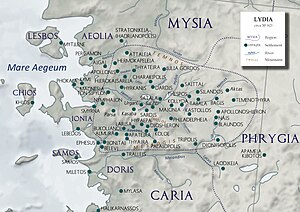Setae (Lydia)

Setae or Setai (Ancient Greek: Σέται), or Settae or Settai (Σέτται), or Saettae or Saittai or Saittae (Σαίτται) was a town of ancient Lydia,[1] located at Sidas Kaleh[2][3] in Modern Turkey.[4][5] The ruins of that town consist of a stadium,[6] tombs and ruins of several temples.[7][8] The town is not mentioned by any of the earlier writers, but appears in Ptolemy[9] and Hierocles.[10]
Location[edit]
The city lying between the upper reaches of the River Hermus and its tributary the Hyllus,[11] and was part of the Katakekaumene.
Its site is located at Sidas Kale, near İcikler in Asiatic Turkey.[12][13]
History[edit]
The city struck coins and was visited by the Emperor Hadrian.[14]
The Apollo Aksyros Temple located in the ancient city. According to the researchers in one of the stele of the temple, there is an inscription which writes "Melita and Makedon stole Eia’s fishnet and other belongings. Therefore, they were punished by God. Their parents consulted Apollon Aksyros for their sake and made a vow,"[15]
Bishopric[edit]
Saittae was also the seat of a Byzantine Bishopric. Bishop Limenius signed the Chalcedon Creed[16] while Bishop Amachius[17][18] spoke at the Council of Chalcedon. Limenius signed the documents at the Council of Ephesus.[19] Although an Islamic area now, under the name Saittae it remains a titular see of the Roman Catholic Church.[20]
References[edit]
- ^ Michael Greenhalgh, From the Romans to the Railways: The Fate of Antiquities in Asia Minor (BRILL, 25 Sep. 2013) p5.
- ^ The Journal of the Royal Geographical Society, Volume 8 (Royal Geographical Society (Great Britain), 1838) p 142.
- ^ William John Hamilton, Researches in Asia Minor, Pontus, and Armenia,: With Some Account of Their Antiquities and Geology [in 1836], Volume 2 (John Murray, 1842) p 145.
- ^ Michael Greenhalgh, From the Romans to the Railways: The Fate of Antiquities in Asia Minor(BRILL, 25 Sep. 2013) p 30.
- ^ Saittai, Manisa (Provinz).
- ^ Michael Greenhalgh, From the Romans to the Railways: The Fate of Antiquities in Asia Minor (BRILL, 25 Sep. 2013) p30.
- ^ Saittae at Perseus.tufts.edu.
- ^ William John Hamilton, Researches in Asia Minor, Pontus and Armenia, Volume 1 (Georg Olms Verlag, 1984) p144.
- ^ Ptolemy. The Geography. Vol. 5.2.21.
- ^ Hierocles. Synecdemus. Vol. p. 669.
- ^ The Literary Gazette: A Weekly Journal of Literature, Science, and the Fine Arts (H. Colburn, 1842) p824.
- ^ Richard Talbert, ed. (2000). Barrington Atlas of the Greek and Roman World. Princeton University Press. p. 62, and directory notes accompanying. ISBN 978-0-691-03169-9.
- ^ Lund University. Digital Atlas of the Roman Empire.
- ^ Anthony R Birley, Anthony R. BirleyHadrian: The Restless Emperor (Routledge, 15 Apr. 2013) p168.
- ^ 1800-year-old stele on way back from Italy after 23 years
- ^ Richard Price, Michael Gaddis, The Acts of the Council of Chalcedon, Volume 1 (Liverpool University press, 2005) p336.
- ^ Richard Price, Michael Gaddis, The Acts of the Council of Chalcedon, Volume 1 (Liverpool University Press, 2005) p 85.
- ^ Catholic Heirchy.org
- ^ Richard Price, [https://www.academia.edu/9979005/Politics_and_Bishops_Lists_at_the_First_Cou ncil_of_Ephesus Politics and Bishops’ Lists at the First Council of Ephesus] Annuarium Historiae Conciliorum 44 (2012), 395-420.
- ^ "Saittae (Titular See) [Catholic-Hierarchy]".
![]() This article incorporates text from a publication now in the public domain: Smith, William, ed. (1854–1857). "Setae". Dictionary of Greek and Roman Geography. London: John Murray.
This article incorporates text from a publication now in the public domain: Smith, William, ed. (1854–1857). "Setae". Dictionary of Greek and Roman Geography. London: John Murray.


 French
French Deutsch
Deutsch